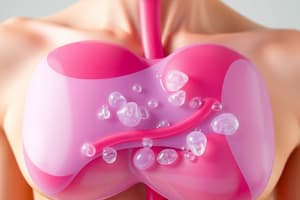Podcast
Questions and Answers
What is the primary cause of the fluid retention in SIADH?
What is the primary cause of the fluid retention in SIADH?
- Decreased glomerular filtration rate
- Increased permeability of the renal distal tubule and collecting duct (correct)
- Increased sodium levels in the blood
- Decreased production of antidiuretic hormone (ADH)
What is the common effect of SIADH on serum sodium levels?
What is the common effect of SIADH on serum sodium levels?
- Sodium levels fluctuate significantly
- Normal sodium levels
- Hypernatremia
- Hyponatremia (correct)
Which of the following is a clinical manifestation of SIADH that can occur with severe hyponatremia?
Which of the following is a clinical manifestation of SIADH that can occur with severe hyponatremia?
- Increased urine output
- Decreased body weight
- Increased thirst
- Muscle cramps (correct)
What is the most common cause of SIADH?
What is the most common cause of SIADH?
Which of the following diagnostic tests is crucial for confirming a diagnosis of SIADH?
Which of the following diagnostic tests is crucial for confirming a diagnosis of SIADH?
What is the typical characteristic of urine specific gravity in patients with SIADH?
What is the typical characteristic of urine specific gravity in patients with SIADH?
What is the typical effect of SIADH on glomerular filtration rate?
What is the typical effect of SIADH on glomerular filtration rate?
Which of the following conditions can be associated with a chronic form of SIADH?
Which of the following conditions can be associated with a chronic form of SIADH?
Which of the following symptoms may occur with SIADH?
Which of the following symptoms may occur with SIADH?
What type of cancer is most commonly associated with SIADH?
What type of cancer is most commonly associated with SIADH?
Which of these medications is NOT listed as a potential cause of SIADH in the text?
Which of these medications is NOT listed as a potential cause of SIADH in the text?
What is the recommended fluid restriction for patients with mild SIADH?
What is the recommended fluid restriction for patients with mild SIADH?
Which of the following is NOT a potential complication of SIADH?
Which of the following is NOT a potential complication of SIADH?
Which type of diuretic is specifically mentioned as a potential treatment for SIADH?
Which type of diuretic is specifically mentioned as a potential treatment for SIADH?
In patients with SIADH, the use of loop diuretics may require the administration of which of the following?
In patients with SIADH, the use of loop diuretics may require the administration of which of the following?
What is the recommended treatment for severe hyponatremia (sodium level less than 120 mEq/L) in the presence of neurologic manifestations?
What is the recommended treatment for severe hyponatremia (sodium level less than 120 mEq/L) in the presence of neurologic manifestations?
What is the primary mechanism of action of demeclocycline in treating SIADH?
What is the primary mechanism of action of demeclocycline in treating SIADH?
What is the recommended position for patients with SIADH?
What is the recommended position for patients with SIADH?
Which of the following is an orally administered vasopressor receptor antagonist used to treat SIADH?
Which of the following is an orally administered vasopressor receptor antagonist used to treat SIADH?
Which of the following is NOT a recommended self-management strategy for chronic SIADH?
Which of the following is NOT a recommended self-management strategy for chronic SIADH?
Flashcards
SIADH
SIADH
Syndrome of inappropriate antidiuretic hormone secretion, leading to water retention and dilutional hyponatremia.
ADH
ADH
Antidiuretic hormone that regulates water balance by increasing kidney water reabsorption.
Dilutional Hyponatremia
Dilutional Hyponatremia
Low sodium levels due to excess water, causing symptoms like muscle cramps and irritability.
Fluid Retention
Fluid Retention
Signup and view all the flashcards
Serum Osmolality
Serum Osmolality
Signup and view all the flashcards
Urine Specific Gravity
Urine Specific Gravity
Signup and view all the flashcards
Cerebral Edema
Cerebral Edema
Signup and view all the flashcards
Common Causes of SIADH
Common Causes of SIADH
Signup and view all the flashcards
Clinical Manifestations of SIADH
Clinical Manifestations of SIADH
Signup and view all the flashcards
Diagnosis of SIADH
Diagnosis of SIADH
Signup and view all the flashcards
SIADH Causes
SIADH Causes
Signup and view all the flashcards
Cancers causing SIADH
Cancers causing SIADH
Signup and view all the flashcards
CNS Disorders in SIADH
CNS Disorders in SIADH
Signup and view all the flashcards
Drugs causing SIADH
Drugs causing SIADH
Signup and view all the flashcards
Key Symptoms of SIADH
Key Symptoms of SIADH
Signup and view all the flashcards
Fluid Restriction in SIADH
Fluid Restriction in SIADH
Signup and view all the flashcards
Treatment for Severe Hyponatremia
Treatment for Severe Hyponatremia
Signup and view all the flashcards
Vasopressor Receptor Antagonists
Vasopressor Receptor Antagonists
Signup and view all the flashcards
Symptoms of Electrolyte Imbalance
Symptoms of Electrolyte Imbalance
Signup and view all the flashcards
Daily Weight Monitoring
Daily Weight Monitoring
Signup and view all the flashcards
Study Notes
Syndrome of Inappropriate Antidiuretic Hormone (SIADH)
-
Definition: SIADH results from excessive ADH production or release, despite normal or low plasma osmolarity. ADH increases kidney water reabsorption.
-
Pathophysiology: Increased ADH leads to fluid retention, decreased plasma osmolality, decreased sodium levels (dilutional hyponatremia), and concentrated urine.
-
Etiology: Most commonly caused by cancer (especially small cell lung cancer), head trauma, or medications. Can also be caused by other conditions like CNS disorders and metabolic diseases.
Clinical Manifestations
-
Early symptoms: Thirst, dyspnea, fatigue, muscle cramps, irritability, headache.
-
Severe symptoms (lower sodium levels): Vomiting, abdominal cramps, muscle twitching, lethargy, confusion, seizures, coma, cerebral edema.
Diagnosis
- Diagnostic tests: Measurement of urine and serum osmolality. Key indicators include: serum sodium less than 135 mEq/L, serum osmolality less than 280 mOsm/kg, and urine specific gravity greater than 1.030.
Treatment
-
Mild cases (serum sodium > 125 mEq/L): Fluid restriction of 800-1000 mL/day. Monitor for weight loss, and gradual rise in sodium and osmolality.
-
More severe cases (severe hyponatremia): Fluid restriction of 500 mL/day. Careful slow correction of sodium levels (no more than 8-12 mEq/L/day) with possible IV hypertonic saline to avoid osmotic demyelination.
-
Medications: Loop diuretics (like furosemide) can promote diuresis, but only if sodium levels are above 125mEq/L. Demeclocycline blocks ADH effects. Vasopressor receptor antagonists (conivaptan and tolvaptan) for hospitalized cases of euvolemic hyponatremia. Avoid these medications if liver disease is present
-
Important considerations: Seizure precautions for patients with altered sensorium or seizures, keep the patient's head slightly elevated when possible(under 10 degrees). Monitor fluid intake and output, vital signs, electrolytes to avoid further complications, frequent position changes.
Chronic SIADH Management
-
Fluid restriction: 800-1000 mL/day. Offer ice chips or sugar-free gum to manage thirst.
-
Dietary supplements: Encourage dietary sodium and potassium.
-
Monitoring: Daily weights are crucial for assessing fluid balance. Teach patients symptoms of fluid and electrolyte imbalances impacting sodium and potassium levels.
Studying That Suits You
Use AI to generate personalized quizzes and flashcards to suit your learning preferences.




